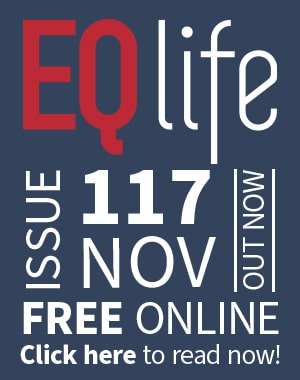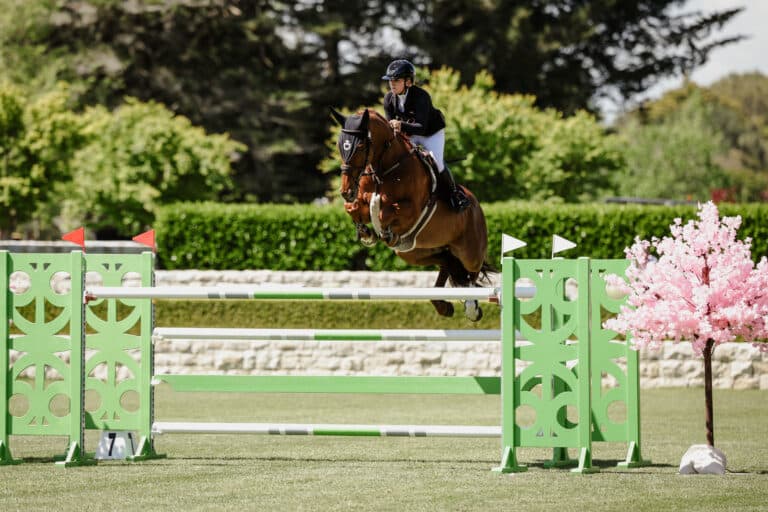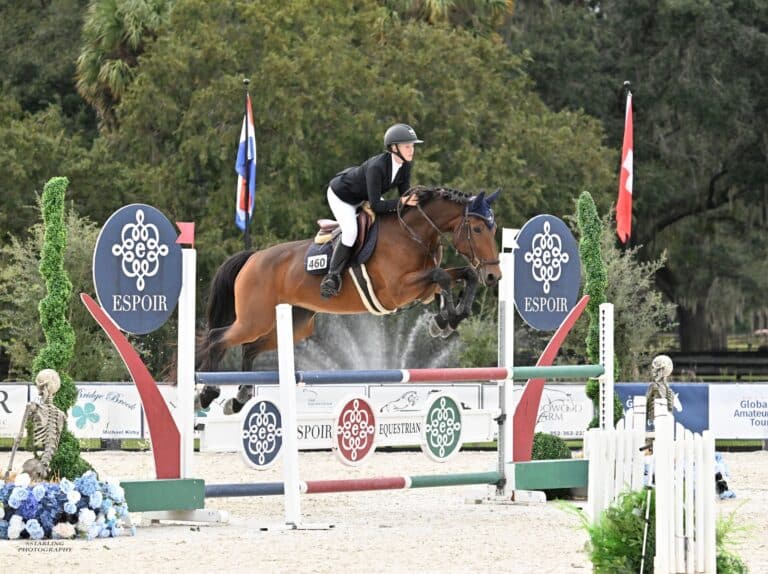In a statement today the FEI General Assembly has announced that the restructured FEI Jumping Rules, which will take effect on 1 January 2026, have been approved.
Notably, the proposed Article 259 on Jumping Recorded Warnings – including the controversial ‘blood rule’ change – was also approved. Article 259 was voted on separately; national federations voted 56-20, with two abstaining.
“We acknowledge that a number of National Federations voted against the proposal. While their reasons may vary, we take this outcome seriously and are committed to examining it carefully to better understand the concerns and address them as we move forward,” FEI Secretary General Sabrina Ibanez said.
So, what has changed?
Current FEI Jumping Rules (Article 241)
The current FEI Jumping Rules stipulate that any blood on the flanks results in elimination, while blood in the mouth depends on the severity and whether the bleeding continues.
Article 241
3. The following paragraphs lay down the reasons for which Athletes are eliminated in Jumping Competitions. The Ground Jury must enforce Elimination under the following circumstances:
3.30. Blood on the Horse’s flank(s);
3.31. Horses bleeding in the mouth (in minor cases of blood in the mouth, such as where a Horse appears to have bitten its tongue or lip, Officials may authorize the rinsing or wiping of the mouth and allow the Athlete to continue; any further evidence of blood in the mouth will result in Elimination)
New rules for 2026 (Article 259 Jumping Recorded Warnings)
The newly approved rules mean any blood on the horse requires a vet inspection to see if they are fit to continue competing. There is no longer compulsory elimination for blood on the flanks – however, disqualification must be imposed if there are marks indicating excessive use of spurs or the whip (this comes under a different rule, Article 264 Disqualification).
Any blood on the horse caused by tack, equipment or the athlete results in a warning, while blood from something such as a bitten tongue will not – however, the horse must still be passed fit to continue competing either way.
Article 259
259.1. Any blood on the Horse caused by tack or equipment or any Athlete induced blood detected during a competition (from warm up until completion of any post-Competition controls/testing) will result in the following consequences for the Person Responsible, issued by the President of the Ground Jury:
First Offence – Jumping Recorded Warning
Second Offence – Jumping Recorded Warning
Should the same Person Responsible receive two or more Jumping Recorded Warnings at the same or any other Event within 12 months of the delivery of the first Jumping Recorded Warning, the Person Responsible shall be issued with a fine of CHF 1’000 and be automatically suspended for a period of one month. (Note, the full rules also detail how the suspension is applied.)
259.1. In other cases of blood on the Horse detected during a Competition (for example where a Horse appears to have bitten its tongue or lip or in cases where a Horse is bleeding from the nose), the Officials may authorise the rinsing or wiping of the blood and allow the Athletes/Horse Combination to continue the Competition, provided the Horse is deemed fit to compete in accordance with Article 259.3. The Athlete will not receive a Jumping Recorded Warning if this Article applies.
259.3. In all cases of blood on the horse under JRs Art 259, the Horse may only be permitted to continue in a Competition or participate in any Subsequent competition(s) at the Event if the Ground Jury, in consultation with the Veterinary Delegate, has deemed the Horse to be fit to compete.
340,000 starts, 101 blood related eliminations
Prefacing the discussions on Article 259 on Jumping Recorded Warnings at the FEI General Assembly, FEI Jumping Director Todd Hinde shared statistics from this year, noting that there were 340,000 starts, with 101 blood related eliminations, of which most were due to blood on the flanks, representing 0.029 percent of all starts. Of these, only four athletes were eliminated twice during that period. He highlighted that this significantly reduced number of cases reflects the impact of the rules on spurs which was put in place in the past, which better clarified what is permitted and what is not.
‘No blood on horses – no exceptions’
Prior to this latest FEI announcement, many were saying the proposed rule changes represent a shift away from the long-standing “no blood on horses – no exceptions!” and called on the FEI to reject what campaigners describe as a dangerous step backwards for welfare and public trust in the sport.
Sparked by the proposed rule amendments, a Change.org petition gaining over 65,000 signatures states: “The No-Blood Rule is one of the most important welfare protections in equestrian sport: Whenever blood becomes visible on a horse during competition, the performance must be stopped.”
Its initiator, Claudia Sanders, writes: “The No-Blood rule is more than just a regulation – it is a symbol of respect, empathy, and responsibility in our relationship with horses. If we weaken this boundary, we lose a fundamental moral compass in equestrian sport.”
FEI says rule changes are ‘a meaningful advancement’
In approving Article 259, the FEI says National Federations have “acknowledged the Rule as a meaningful advancement, enhancing horse welfare through added measures and safeguards”.
In today’s statement, the FEI says these added measures and safeguards include:
- New mandatory fitness-to-compete checks by the Ground Jury, in consultation with the Veterinary Delegate, in all cases of blood.
- Horses now only permitted to continue competing if passed fit-to-compete following the above Veterinary check.
- Clearer rules for FEI Officials, removing the “minor” distinction and ensuring greater consistency and objectivity.
- Increased transparency and accountability for athletes, with all Jumping Recorded Warnings published by the FEI.
- Automatic notification to National Federations of all Jumping Recorded Warnings concerning their athletes, enabling them to better monitor cases and decide whether to impose additional welfare checks or measures.
The FEI also notes the following rules are still in place and remain unchanged:
- Mandatory disqualification for excessive use of spurs;
- The Abuse of Horse provisions; and
- The possibility of opening separate disciplinary proceedings to impose additional sanctions.
“We fully acknowledge and thank the National Federations for the constructive discussions throughout the week, which clearly reflected a shared commitment to finding solutions,” FEI Secretary General Sabrina Ibanez said.
“Despite differing opinions, we were able to gain a clearer understanding of each other’s positions and were also able to clarify several misunderstandings and misconceptions.
“We acknowledge that the approval was not unanimous and have taken note of the request from several National Federations for a more harmonised approach to the topic across disciplines and we are committed to looking into this.
“We will take a structured, evidence-based approach grounded in thorough consultation and driven by data. Our ongoing projects at the FEI will play a key role in supporting accurate data recording, and we will continue to advance safety and welfare through evidence-based measures that are both rigorous and robust to further demonstrate our unwavering support to horse welfare.”








